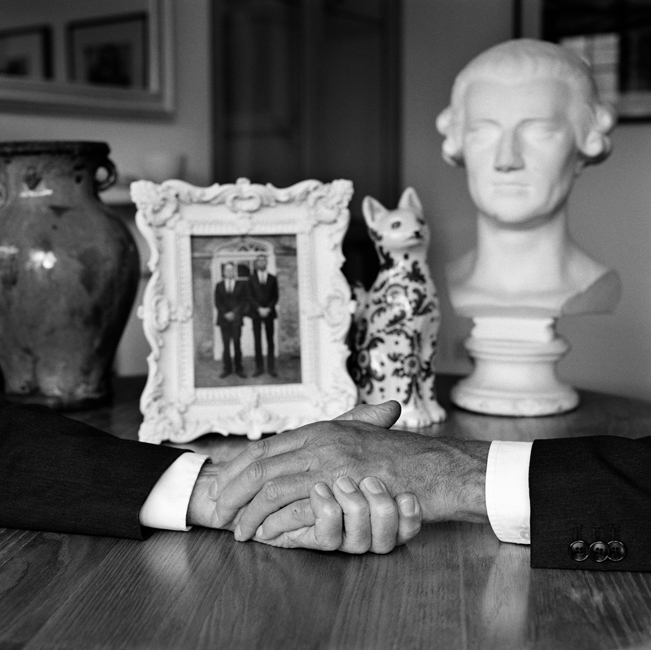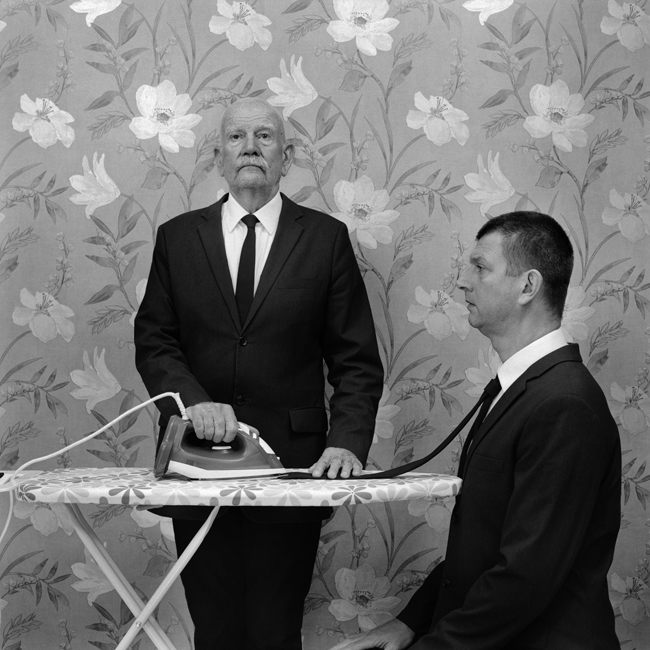
An interview with photographer John Paul Evans, by Redeye intern Bryan Beresford.
Following the change in gay marriage laws, proposed in 2014, photographer John Paul Evans began to explore his 26-year relationship with then civil, and now married partner, to create a 'series of absurd permutations of the wedding portrait’. After discovering that there were few photographs of their relationship, John created these alternative portraits to redress this visual absence in an absurd and comical fashion. With John in his 50s and his partner in his 70s, the project is used to investigate the 'normality' of their relationship and examines how the photographic medium is often used to reinforce social and cultural norms.
In this interview I caught up with John to chat to him about the project, and found out more about his work and approach to photography.
Could you tell us a bit more about your background and what you do?
As an artist and academic, I have worked primarily on photographic courses, but in a fine art context over the last 20 years. I decided to leave my post as senior lecturer in Photography at UWTSD Swansea in the summer of 2015 in order to permanently locate to Devon and focus on creative work.
Could you tell us a bit more about the project Till Death Do Us Part?
The works originated as a personal reflection on the current state of social change in Britain, Europe and America around notions or definitions of marriage. The political and social debate triggered a desire to explore this genre with my then civil partner, and now married partner, Peter. From an academic point of view I was critical of the way that photography is used to reinforce concepts of the family and normality. As a consequence, I have very few images to represent the 27 years that Peter and I have spent together. As I am now entering my 50s and Peter is in his late 70s, there was an urgency to address this in my own mind in order to leave a trace of our presence in the world.
Our performance of various permutations of the couple/marriage/wedding portrait is a way of addressing this for me in creating an alternative family/wedding album. I am aware that Peter and I are not what would be considered as an ideal couple by mainstream media. There is a 27-year age difference and in real life we have sometimes been confused as father and son. But that is the reality of my 'lived' experience, and on one level I see these works as a personal memoir of two people at different stages in their personal chronology, exploring ideas of space, place and time.
It was all of these differences and visual discrepancies that made me want to explore an ongoing body of images, that reflect on a couple who in some ways seem like outsiders or alien, as a metaphor for the concept of ‘otherness’.

You’ve stated before that you wanted to do this project because you didn’t have 'conventional' images of you together as a couple. Are there any other reasons why you wanted to make this work?
There is never one single reason for making creative images. I have made statements that address the representation of a personal relationship and how that is mediated to a wider audience. But I would have to say that my interest in photography began in the 1980s when various artists and photographers were using the medium as a mode of representation to question and challenge the way photography is deployed culturally to reinforce ideas of class, gender or ethnicity, to state a few examples. As a young man from a working-class background who was coming to terms with a sexual identity in a politically and socially hostile climate, photography played an important role in addressing who I wanted to be. As a consequence, the field of gender representation has formed my primary interest in photography.
In the project Till Death Do Us Part you’re working very intimately in the family home with your spouse. Do you ever find this emotionally challenging to live and work on a project in the same environment and does Peter have much input into your work?
The restriction of working within limitations can often be creatively liberating. Our house is very confined as a space and my studio is equally small. This has led me to rethink certain ideas that have made an initial impression in my mind and as a result some compositions look, close or even claustrophobic which can be a useful visual metaphor for some of the ideas I am exploring. I see Peter as the star of the work. His deadpan impression lends the work a sense of tragic-comedy that seems melancholic. Although I need to trust my own instincts as a creative person, Peter is still someone I will always refer to for opinion.

Your work seems to be inspired academically but from a visual perspective what inspires you?
I don’t necessarily see the two things as exclusive. For instance, in referencing the Arnolfini wedding portrait or Gainsborough’s Mr. & Mrs. Andrews, I am interested in both the visual qualities of the painting as well as what these images represent historically. In terms of photography I have found John Coplans, Rosy Martin and Duane Michals and Claude Cahun inspiring in terms of representing the body, questions of aging, gender and sentiment. There are certain Angus McBean images that have left a lasting impression and are part of my subconscious.
I notice in Till Death Do Us Part a sense of playfulness and comedy as you said so yourself in and interview for BJP but there is also an underlying tone of romance in some of the images (the floral patterns veils, household ornaments, the use of black and white), but also I notice some have connotations of loss (the laid out clothes on the bed, reflection’s) Is there an intentional link between romance and loss in this project?
Yes, the two things are inevitably connected. To quote a famous song, 'who knows where the time goes?' I am aware that the 27 years I have known Peter has disappeared ‘in the blink of an eye’. These moments can never be captured or preserved by the camera. As Roland Barthes pointed out, the photographic moment only alerts us to the fact that the time has passed and can never be regained. No matter how much we try to preserve our loved ones with the camera, the photographic moment only testifies to their passing. This is why the sense of playfulness or distance from reality was important for me deal with the fact that Peter and I are at different stages in life.

You state in an interview with StrantMag that the 'images work as a visual analogy of transcoding, taking on board perceived fears or stereotypes'. Do you think projects like this and others will shift these perceptions and fears over time?
In the microphysics of power, Foucault puts forward the idea of power operating in capillary fashion, not only from the top down but in networks spreading out, permeating society. The possibilities in acknowledging power operating in this way is that it allows people to transform the prevailing cultural codes through individual acts within the field of power/knowledge In this sense any work has the possibility of changing, or conversely, reaffirming opinions.
The internet might be used as a useful analogy of this idea of power networks. We might argue that these networks can’t overthrow governments directly, but they can change the way we think about things and they can alert us to who is doing the talking and on whose behalf they speak. I would have never believed as a young man in the 1980s that gay marriage would be law in Great Britain in the 21st century. For Peter’s part growing up in a period where being homosexual was illegal and only partially decriminalized in 1967 as a consequence of the Wolfenden report then we would have to acknowledge that things have shifted considerably in terms of gay rights in western culture. But we shouldn’t be complacent as there will always be people who given the chance would like to shift power in another direction. We only have to look at the consequence of the Brexit vote to realize that.
For anyone wanting to explore similar themes as your self what advice would you give to them?
You have to believe that it’s an important thing to do. There will be times when your work is being shown or winning awards and there will be times when things go very quiet, but you have to believe that your work is important regardless of what other people might say.
Are you working on anything at the moment?
As a recipient of the Hasselblad Masters Award 2016 I was loaned a H5D camera to produce a body of images for the Award. I have made a series with Peter and myself entitled ‘kings, queens and fairy tales. I am delighted that Hasselblad have selected 14 images from the series to be featured in the Hasselblad Masters 2016 publication, which will be launched at Photokina in Cologne in September 2016.
John is the recipient of the Hasselblad Masters Award 'Wedding' category in 2016 for Till Death Do Us Part. You can see more of his work on his website.
By Bryan Beresford - intern at Redeye, the Photography Network
All images by John Paul Evans